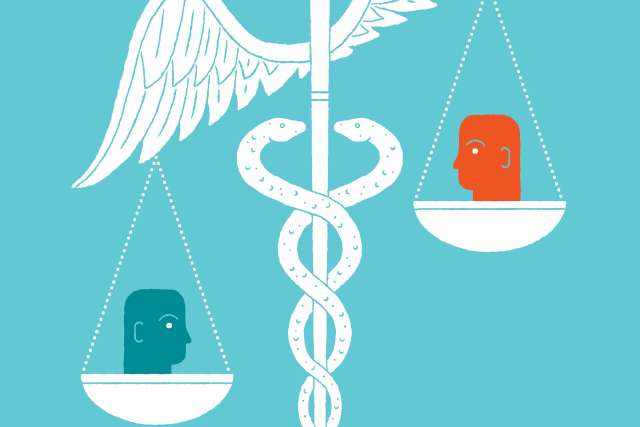STRUCTURAL RACISM IS A FORM OF RACISM that is embedded in the laws, policies, institutions and practices of society that provide advantages to certain racial groups while disadvantaging others. Although structural racism is well documented as an important contributor to health care inequities, its effects on medical students, trainees and faculty have received less attention. We believe aversive racism is a critical and overlooked contributor to structural racism in academic medicine.
Aversive racism, an established construct in social psychology, is defined as exhibiting racist tendencies while denying that one’s thoughts, behaviors or motives are racist. According to John Dovidio and Samuel Gaertner, who defined the concept in the 1990s, aversive racism occurs when people endorse egalitarian values in principle, but when faced with ambiguous situations or unclear guidelines, discriminate against people from historically marginalized groups while rationalizing or justifying their actions on the basis of factors other than race. Aversive racism is pervasive in both academic medicine and society at large. In areas ranging from medical school admissions decisions to executive-leadership appointments, aversive racism in academic medicine impedes diversity, equity and inclusion efforts. Understanding this construct and developing strategies for combatting aversive racism will help diversify academic medicine and reduce health disparities.
Aversive racism undermines the substantial investments in antiracism initiatives that many institutions have made to combat structural racism. One manifestation of aversive racism in academic medicine is ongoing inequalities in the promotion of faculty from historically marginalized groups. Although Asian students and students from groups that are underrepresented in medicine (URM) made up 31% of U.S. medical school graduating classes in 2018, Asian and URM faculty accounted for only 18-to-19% of full professors in perioperative and primary-care specialties.
The residency-application process is another area where aversive racism has substantial effects. Program directors may unwittingly rationalize the selection of a less-diverse incoming residency class by lamenting the lack of qualified applicants from diverse backgrounds, rather than acknowledging the barriers facing URM applicants in the selection process. URM students are less likely to receive honors grades on their clinical clerkships and are awarded fewer honor-society memberships upon graduation than white students. The grades assigned during third- and fourthyear clerkships are more subjective and more susceptible to bias than the pass-fail grade commonly used during the preclinical years. This system impedes URM students’ chances of matching in competitive residency programs, thereby perpetuating disparities in academic medicine.
The same mechanisms are at play when URM candidates for leadership positions are evaluated less favorably than their equally qualified white peers. Using subjective phrases such as “not a good fit,” “not what we’re looking for” or “I’m going with my gut on this” allows an evaluator’s biases to hold sway when guidelines are ambiguous.
In the language of social psychology and sociology, aversive racism results from the interplay of normal cognitive processes, including social dominance, implicit bias and in-group favoritism. Aversive racism flourishes when decisions are left to judgment calls by people who don’t recognize the effects of intergroup dynamics on their thought processes. Social-dominance theory explains the mechanisms behind the inevitability of group-based hierarchies. According to this theory, society and social systems have at least two groups — the dominant or top group, which has the most of whatever attribute society deems valuable (e.g., power or money), and the less-dominant group or groups.
When it comes to race, the hierarchy is upheld by institutional racism (racial discrimination within financial, legal and education systems, among others); interpersonal racism (discrimination, overt or aversive, by members of the dominant group against members of less-dominant groups); and internalized racism (conscious or unconscious acceptance of the racial hierarchy by members of less-dominant groups). To avoid sanctions or to move up the hierarchy, members of less-dominant groups tend to show deference to members of the dominant group, a process that reinforces and perpetuates this hierarchy, whereas people at the top often deny that a group-based hierarchy exists.
The hierarchy is maintained in part by societal myths that legitimize inequity. People at the top of the hierarchy not only have a stronger preference for hierarchical societies than members of less-dominant groups, but they are more likely to endorse such legitimizing myths. In academic medicine, myths that legitimize inequity include the concept of a meritocracy — the idea that success is based primarily on a person’s abilities, which ignores the effects of structural and aversive racism on opportunities. Implicit bias — the unconscious, automatic association of negative stereotypes or attitudes with a particular group — also helps maintain inequality.
Implicit bias works in concert with in-group favoritism, which entails preferring members of one’s own group to outsiders. When faculty members interview residency applicants, for example, in-group favoritism manifests when an interviewer ranks students from a school they personally attended higher than they otherwise would have, thereby disadvantaging other applicants. Aversive racism occurs when people fail to recognize the influence of these forces on their judgments. Social dominance, implicit bias and in-group favoritism intersect within academic medicine, resulting in aversive racism that affects the judgments of decision makers and contributes to structural racism in medicine.
Behaviors that reflect aversive racism are harmful to people from historically marginalized groups but maintain the positive self-image of the people carrying them out. For example, Dovidio and colleagues had white college students evaluate hypothetical university applicants. Participants had previously completed a questionnaire, which was used to stratify them into high-prejudice and low-prejudice groups (although even the high-prejudice students ranked low on measures of prejudice as compared with the general population). Participants then evaluated admissions packets of Black and white applicants that were constructed to reflect high, low or ambiguous academic achievement. There was no difference between high- and low-prejudice participants’ evaluations of high- or low-achieving applicants, regardless of the applicant’s race. When evaluating applicants with ambiguous achievement records, however, high-prejudice participants rejected Black applicants significantly more often than they rejected white applicants. The investigators concluded that the ambiguity of the application allowed participants to justify their admissions decisions to themselves by focusing on the application’s weaknesses.
The COVID-19 pandemic unmasked the structural racism that exists throughout the United States. Academic medicine isn’t immune to the scourge of white supremacy and structural racism. No matter how many institutional statements are made condemning racist acts, we cannot expect to overcome structural racism within academic medicine until we acknowledge the reality of aversive racism. In addition to examining their role in upholding a race-based hierarchy, members of the academic-medicine community must do the difficult work required to challenge their own conscious and subconscious thoughts and actions that contribute to aversive racism. This work includes unlearning implicit biases, countering negative stereotypes and legitimizing myths, and eliminating the use of automatic, biased judgments to make decisions, all of which will require extensive and deliberate practice.
Future work will involve developing evidence-based anti– aversive-racism programs to break down academic medicine’s unspoken racial hierarchy, which contributes to structural racism in health care. Effective programs would help normalize antiracist attitudes; provide continuous and effective antiracism education for trainees, faculty, executive leaders and staff; and refashion existing systems that favor the “in group.” Finally, academic institutions should capitalize on the good intentions and desires of progressive academic leaders to overcome their aversive racist thoughts and actions. We hope academic leaders will lead the charge by acknowledging the need to openly address aversive racism within broader efforts to dismantle structural racism in medicine.


